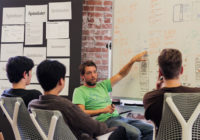This post is a summary of article “The Era of Adaptive Experiences: Rethinking Universal and Inclusive Design” By Kelly Goto published in DMI Magazine Vol30, Issue 3.
AS GEDS, we are leading the design of MATUROLIFE, an award winning user-driven innovation project designed to help make independent urban living easier for older people via smart products. We followed inclusive design principles and have done a comprehensive design research to make products accessible, easy to use and meaningful for older people with adaptive multimodal experiences.
We are sharing this article to give background discussions on importance of inclusive design and adaptive multimodal experiences.
Aging is a global issue, as people older than 65 years are projected to make up 21 percent of the global population by 2050. We call this an “issue” because aging brings number of several changes in health conditions and added disabilities, and the world surrounding us is not offering a friendly environment for aging.
While the life expectancy has risen since 1950s, the fact of longer life expectancy doesn’t mean an easier and healthier life. However this can be a starting point for designing better, safer, healthier life for all. Diversity enriches design; Ethnicity, gender, age and disability creates diversity and give designers other opportunities to embrace and celebrate differences. The diminishing physical and cognitive abilities shouldn’t be considered as impairments as Michael Nesmith – a hearing-impaired designer- states; “Disability drives innovation”. Instead of being an obstruction, these changes in human ability force designers to come up with better and more accessible solutions.
Accessibility means being available and approachable and there are multiple approaches for designing accessible products. For example, Universal Design emphasize bringing diversity mindset into action to drive innovative approach towards designing useful and meaningful solutions for wider audiences, regardless of their age or ability. Whereas Inclusive Design emphasizes designing meaningful and valuable experiences for extreme users, rather than for average users. Lately with the increasing number of smart devices used in everyday life, adaptivity as well come into the action of designing accessible experiences.
Maintaining independence for older adults gets harder because of a decline in the physical abilities such as vision, hearing, dexterity, and diminishing cognitive abilities like memory or comprehension. Adaptive products have the ability to transform depending on different conditions, which is widely used to describe the digital assistive products and services nowadays. So designers are welcomed to create adaptive multimodal experiences using voice, touch, gestures, and haptics to deliver innovative solutions for diverse and specialized needs of older adults.
For designing accessible products, it is important to understand the needs and behaviors of people during daily life, work or leisure. Several research methods such as immersion, interviews or observations used to create empathy with disabilities. Emerging smart home appliances can bridge the gap, however designers must keep on addressing actual problems and targeting the needs of aging seniors, empowering them with adaptive experiences.
Image credit: Tiago Muraro
If you have questions or comments you can contact with us.



